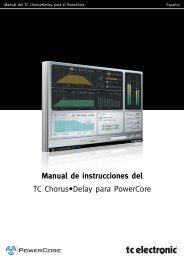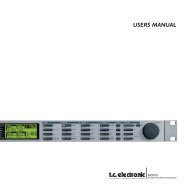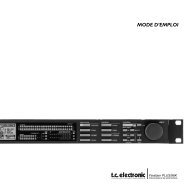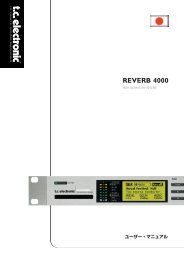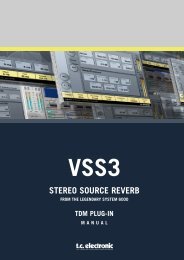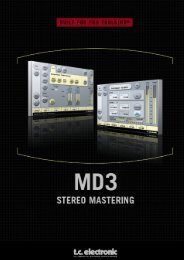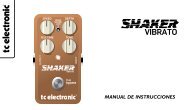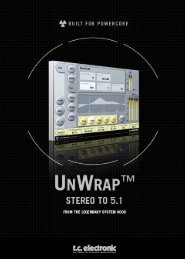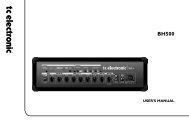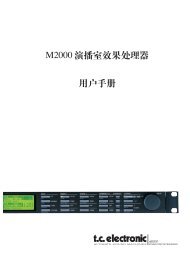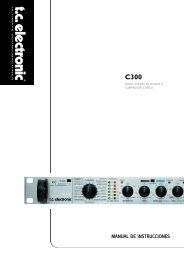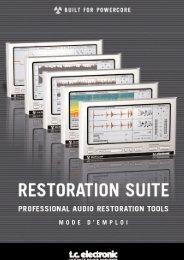EQ Station Manual v. 2.01 sw. 220 English - TC Electronic
EQ Station Manual v. 2.01 sw. 220 English - TC Electronic
EQ Station Manual v. 2.01 sw. 220 English - TC Electronic
You also want an ePaper? Increase the reach of your titles
YUMPU automatically turns print PDFs into web optimized ePapers that Google loves.
<strong>EQ</strong> STATION IN A LOCAL AREA NETWORK<br />
Introduction<br />
This section describes basic elements of a standard<br />
LAN (Local Area Network), and how to apply these<br />
when setting up one or more <strong>EQ</strong> <strong>Station</strong>s in a network.<br />
This is relevant when updating <strong>EQ</strong> <strong>Station</strong> software<br />
from a PC or when controlling <strong>EQ</strong> <strong>Station</strong>s e.g. via a<br />
Tablet PC in live applications or when using more than<br />
8 channels.<br />
Basic terms<br />
<strong>TC</strong>P/IP address<br />
The <strong>TC</strong>P/IP address is unique to each unit connected in<br />
the network. Two units in a network must therefore never<br />
have the same IP address. However, to see each other the<br />
first three digits which per default are “192.168.1” for the<br />
<strong>EQ</strong> <strong>Station</strong> MUST be the same.<br />
The <strong>EQ</strong> <strong>Station</strong>s default IP address is: 192.168.1.100<br />
Subnet Mask<br />
The Subnet Mask defines a group of units in the network.<br />
That covers both <strong>EQ</strong> <strong>Station</strong>s and computers etc.<br />
For the units to see each other the Subnet Mask MUST be<br />
identical.<br />
The <strong>EQ</strong> <strong>Station</strong> default Subnet mask is: 255.255.255.0<br />
Specifically for the <strong>EQ</strong> <strong>Station</strong><br />
The <strong>EQ</strong> <strong>Station</strong> also has a few other interesting networkrelated<br />
topics. (please also see the description of the Setup<br />
- Network and Devices page and also the “Quick Setup<br />
Reference” at pages 6-7)<br />
Device Name:<br />
A name that is assigned to each individual <strong>EQ</strong> <strong>Station</strong>.<br />
The Device Name MUST be unique for each unit !<br />
As all <strong>EQ</strong> <strong>Station</strong>s in a Subnet Mask can be operated from<br />
any of the units within the Subnet, the Device Name also<br />
serves as a convenient identifier. The name will appear in<br />
the operating displays.<br />
Using a HUB-<strong>sw</strong>itch or not ?<br />
As illustrated on the previous page setups can be made<br />
with or without a HUB-<strong>sw</strong>itch. Generally it can be said that<br />
there is no need to use a <strong>sw</strong>itch in minor setups with just at<br />
few <strong>EQ</strong> stations and maybe a PC connected. However, as<br />
soon as the setups expand, increased speed on the update<br />
of the <strong>EQ</strong> <strong>Station</strong> user-interfaces is achieved by placing<br />
one or more <strong>sw</strong>itches in the setup at convenient places.<br />
(see illustration at the previous page)<br />
Be aware<br />
- when no HUB or <strong>sw</strong>itch is used you must use Crosscoupled<br />
Ethernet CAT-5 cable for the network<br />
connection.<br />
- when a HUB or <strong>sw</strong>itch is used you must use standard<br />
(non-cross-coupled) ethernet cables.<br />
- when connecting directly to a computer there is an<br />
uncertainty of which cable type to use. Most computers<br />
work with a cross-coupled ethernet cable.<br />
Subnet Mask - <strong>TC</strong>P/IP address<br />
Win 2000 / Win NT / Win XP<br />
The following examples are based on a Windows 2000<br />
operating system. Illustrations etc. may vary slightly<br />
between other operating systems.<br />
Please note that a working <strong>TC</strong>P/IP protocol must be<br />
installed on your computer before attempting to hook up<br />
the computer on the network.<br />
To find the <strong>TC</strong>P/IP address and the Subnet Mask settings<br />
on your computer running Windows 2000:<br />
• Go to Control Panel, Network and Dial UP Connections<br />
• Double-click on your connection and select “Properties”<br />
Device Number:<br />
The Device number specifies in which order, channels will<br />
be assigned to Cluster locations when you perform a<br />
“Cluster Auto Setup”.<br />
(Please read the description of the Global page and also<br />
the “Quick Setup Reference” at pages 6-7).<br />
38




